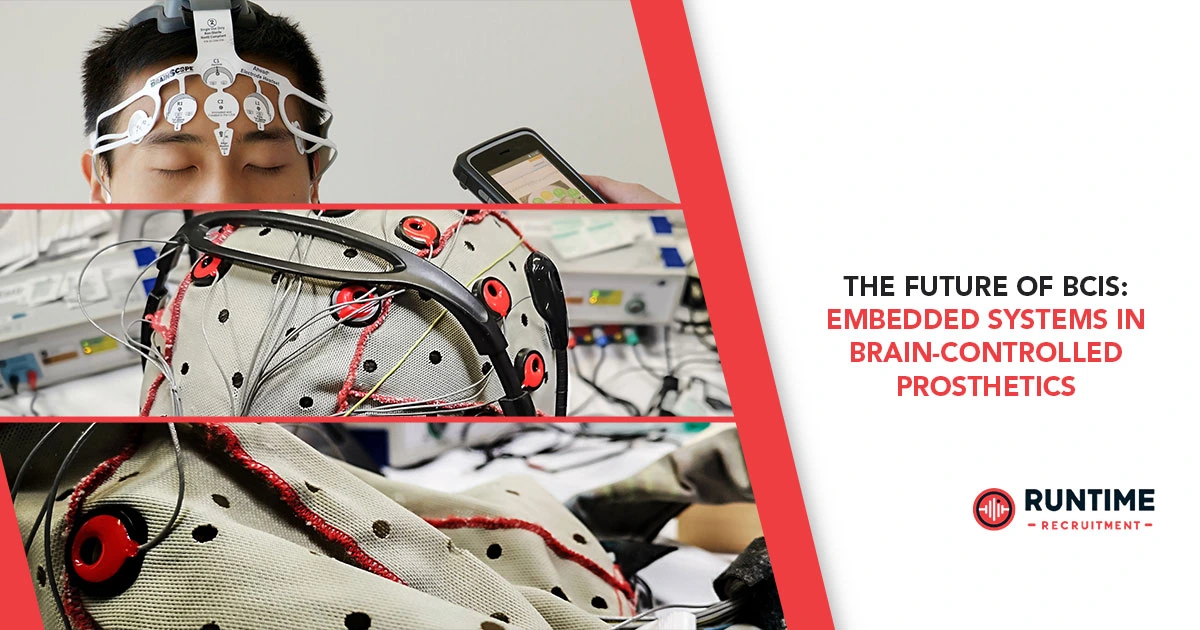The convergence of neuroscience and embedded systems is ushering in a revolutionary era for prosthetics: brain-controlled interfaces (BCIs). These sophisticated systems are no longer confined to the realm of science fiction; they are rapidly evolving into tangible solutions that promise to restore lost motor function and dramatically improve the quality of life for individuals with disabilities. At the heart of this transformative technology lies the intricate and demanding field of embedded systems engineering.
This article delves into the exciting future of BCIs in brain-controlled prosthetics, exploring the key challenges, technological advancements, and the crucial role of embedded systems engineers in realizing their full potential. We will examine the current state-of-the-art, discuss the innovations driving progress, and highlight the critical considerations for developing robust, reliable, and user-friendly neuroprosthetic devices.
Understanding the Fundamentals of Brain-Controlled Prosthetics
At its core, a brain-controlled prosthetic operates by establishing a direct communication pathway between the user’s brain and an external prosthetic limb. This bypasses the traditional neuromuscular pathways that may be damaged or non-functional. The process typically involves several key stages:
- Neural Signal Acquisition: Specialized sensors, implanted or non-invasively placed, detect and record the electrical activity of neurons in specific brain regions associated with motor intent. These signals are often weak and noisy, requiring sophisticated amplification and filtering techniques.
- Signal Processing and Decoding: The raw neural data is then processed by embedded algorithms to extract meaningful information related to the user’s intended movements. This involves complex signal processing techniques, machine learning algorithms, and computational neuroscience principles to decode patterns of neural activity into specific motor commands (e.g., “move hand up,” “grip object”).
- Control Signal Translation: The decoded motor commands are translated into control signals that can be understood by the prosthetic device. This involves mapping the brain’s intentions to the specific actuators and degrees of freedom of the prosthetic limb.
- Prosthetic Limb Actuation and Feedback: The control signals drive the motors and actuators within the prosthetic limb, enabling it to perform the desired movements. Crucially, advanced BCIs also incorporate sensory feedback mechanisms, allowing the user to perceive touch, pressure, and proprioception from the prosthetic, creating a more natural and intuitive control experience.
The Pivotal Role of Embedded Systems
Embedded systems are the unsung heroes driving the advancements in brain-controlled prosthetics. These specialized computer systems, designed for specific tasks within larger mechanical or electronic systems, are responsible for the real-time acquisition, processing, and control that are fundamental to BCI functionality. The demands placed on embedded systems in this context are exceptionally high, requiring:
- Ultra-low power consumption: Implantable BCIs must operate for extended periods on limited battery power to minimize the need for surgical interventions for battery replacement. This necessitates meticulous hardware and software design to optimize energy efficiency at every stage, from sensor acquisition to signal processing and communication.
- Miniaturization and biocompatibility: Implanted components must be extremely small and constructed from biocompatible materials to minimize tissue damage and immune response. This presents significant challenges in terms of packaging, heat dissipation, and long-term reliability within the harsh biological environment.
- Real-time performance: The latency between the user’s neural command and the prosthetic’s response must be minimal (ideally in the order of tens of milliseconds) to provide a natural and intuitive control experience. This requires highly optimized algorithms and efficient hardware architectures capable of processing large volumes of neural data in real time.
- Robustness and reliability: The embedded systems must be highly reliable and fault-tolerant, as malfunctions could have serious consequences for the user. Rigorous testing, redundancy mechanisms, and fail-safe protocols are essential.
- Security and data privacy: BCIs collect sensitive neural data, necessitating robust security measures to protect against unauthorized access and ensure user privacy. Encryption, secure communication protocols, and secure storage are critical considerations.
Current State-of-the-Art and Emerging Technologies
Significant progress has been made in recent years in the field of brain-controlled prosthetics. Some notable advancements include:
- Improved Neural Interfaces: Researchers are developing increasingly sophisticated neural interfaces with higher spatial and temporal resolution, allowing for the recording of more detailed and nuanced neural signals. This includes advancements in microelectrode arrays, electrocorticography (ECoG) grids, and even less invasive techniques like electroencephalography (EEG) with advanced signal processing.
- Advanced Decoding Algorithms: Machine learning and artificial intelligence are playing a crucial role in developing more accurate and robust decoding algorithms that can translate complex patterns of neural activity into precise motor commands. Deep learning techniques, in particular, have shown promising results in learning the intricate relationships between neural signals and intended movements.
- Sophisticated Prosthetic Limbs: Modern prosthetic limbs are becoming increasingly advanced, with multiple degrees of freedom, intricate sensor arrays for feedback, and more biomimetic designs. This allows for a wider range of movements and a more natural appearance and functionality.
- Closed-Loop Control with Sensory Feedback: A major focus of current research is the development of closed-loop BCIs that incorporate sensory feedback. By providing the user with tactile and proprioceptive information from the prosthetic limb, these systems aim to create a more integrated and intuitive sense of embodiment and control. This involves stimulating sensory areas of the brain based on signals from sensors in the prosthetic.
- Wireless and Implantable Systems: The trend is towards fully implantable and wireless BCI systems, which offer greater freedom of movement, reduced risk of infection, and improved aesthetics compared to wired external systems. Advances in low-power wireless communication protocols and miniaturized electronics are making this a reality.
Challenges and Future Directions
Despite the remarkable progress, several challenges remain in the quest to develop truly seamless and widely accessible brain-controlled prosthetics:
- Long-term Stability of Neural Interfaces: Maintaining the long-term functionality and biocompatibility of implanted neural interfaces remains a significant hurdle. The body’s immune response can lead to encapsulation and degradation of the electrodes, reducing signal quality over time. Research is focused on developing more biocompatible materials, coatings, and implantation techniques to address this issue.
- Decoding Complexity and Adaptability: The brain is a highly complex and dynamic system. Developing decoding algorithms that can accurately and reliably translate neural activity into intended movements across different users and over extended periods is a major challenge. Furthermore, the algorithms need to adapt to changes in neural signals and the user’s learning process.
- Achieving Natural and Dexterous Control: Replicating the dexterity and fluidity of natural limb movements with a prosthetic controlled by brain signals is a complex task. This requires high-resolution neural interfaces, sophisticated decoding algorithms that can control multiple degrees of freedom simultaneously, and advanced prosthetic hardware.
- Implementing Robust Sensory Feedback: Providing realistic and meaningful sensory feedback to the user is crucial for achieving a truly intuitive and embodied control experience. This involves not only developing effective sensory stimulation techniques but also understanding how the brain integrates artificial sensory information.
- Addressing Ethical and Societal Implications: As BCI technology advances, it is essential to consider the ethical and societal implications, including issues related to privacy, security, informed consent, and potential misuse of the technology. Open discussions and the development of ethical guidelines are crucial.
The future of BCIs in brain-controlled prosthetics will be driven by continued innovation in several key areas:
- Next-generation neural interfaces: Expect to see the development of even smaller, more flexible, and more biocompatible neural interfaces with higher channel counts and improved longevity. Advances in optogenetics and chemical neurostimulation could also open new avenues for more precise and targeted interaction with the nervous system.
- AI-powered decoding and control: Artificial intelligence and machine learning will play an increasingly important role in developing more sophisticated and adaptive decoding algorithms, as well as in enabling more autonomous and context-aware prosthetic control.
- Biomimetic prosthetic design: Future prosthetics will likely incorporate more advanced materials, actuators, and sensors to more closely mimic the biomechanics and sensory capabilities of natural limbs.
- Personalized and adaptive BCIs: BCIs will become more personalized, with algorithms and interfaces tailored to the individual user’s unique neural signature and specific needs. Adaptive systems that can learn and adjust over time will be crucial for long-term usability.
- Integration with virtual and augmented reality: BCIs could be integrated with virtual and augmented reality technologies to provide immersive training environments and enhance the user’s interaction with the real world.
The Call for Embedded Systems Expertise
The realization of this exciting future hinges significantly on the expertise and ingenuity of embedded systems engineers. These professionals are at the forefront of designing, developing, and implementing the critical hardware and software components that power brain-controlled prosthetics. The field demands a diverse skillset, including:
- Microprocessor and microcontroller architectures: Understanding the intricacies of embedded processors and microcontrollers for efficient computation and control.
- Digital signal processing (DSP): Expertise in filtering, analyzing, and extracting meaningful information from noisy neural signals.
- Real-time operating systems (RTOS): Designing and implementing real-time software for low-latency control and data acquisition.
- Low-power design: Optimizing hardware and software for minimal energy consumption in battery-powered implantable devices.
- Wireless communication protocols: Implementing secure and reliable wireless communication for data transmission and control.
- Biocompatible materials and packaging: Understanding the requirements for implantable medical devices.
- Software development in C/C++ and other relevant languages: Developing efficient and reliable embedded software.
- Machine learning and AI for embedded systems: Implementing and optimizing machine learning algorithms for neural decoding.
- Verification and validation: Ensuring the safety, reliability, and performance of complex embedded systems.
- Knowledge of relevant regulatory standards: Navigating the regulatory landscape for medical devices.
The challenges are significant, but the potential rewards are immense. Embedded systems engineers have a unique opportunity to contribute to a technology that can profoundly impact the lives of individuals with disabilities, restoring lost function and enabling greater independence and quality of life.
The development of brain-controlled prosthetics is a multidisciplinary endeavor, requiring close collaboration between neuroscientists, engineers, clinicians, and ethicists. However, it is the embedded systems engineers who provide the crucial technological foundation upon which this life-changing technology is built. The future of BCIs is bright, and embedded systems will undoubtedly continue to play a central and transformative role in shaping it.
Are you an embedded systems engineer passionate about pushing the boundaries of technology and making a real difference in the world?
Connect with RunTime Recruitment today to explore exciting opportunities in the rapidly evolving field of brain-controlled prosthetics. Let’s build the future of neurotechnology together.









